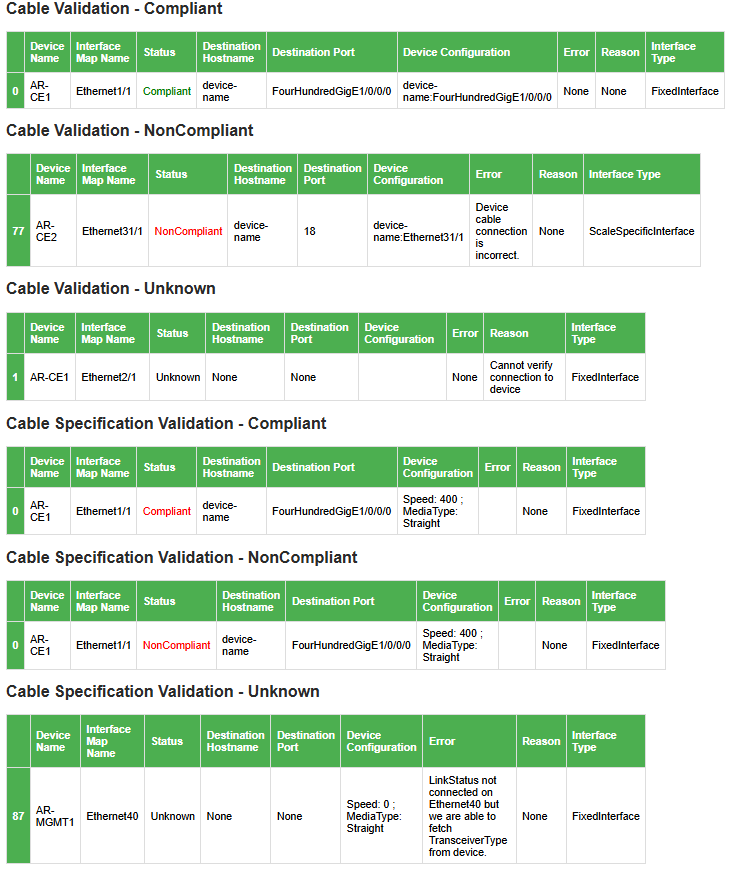Cómo convertir el informe de validación de cables de Tejido de red en HTML
En este artículo se explica cómo convertir un informe de validación de cables de Nexus Network Fabric de salida JSON a HTML.
Requisitos previos
- Requiere Python 3.11 o posterior
- Requiere módulos de Python 3.11:
json pandas as pd datetime
Script de Python para la validación de cables JSON a conversión HTML
import json
import pandas as pd
from datetime import datetime
def color_status(val):
"""
Takes a scalar and returns a string with
the css property `'color: green'` for compliant,
`'color: red'` for noncompliant and black for others
"""
if val == 'Compliant':
color = 'green'
elif val == 'NonCompliant':
color = 'red'
else:
color = 'black'
return 'color: %s' % color
now = datetime.now() # current date and time
date_time = now.strftime("%m-%d-%Y-%H-%M")
print("date and time:",date_time)
# Get the file name as input from the user
file_name = input("Please provide post validation json file: ")
# Load the JSON data from the file
with open(file_name, 'r') as f:
data = json.load(f)
# Prepare two lists to store the data
cable_validation_data = []
cable_specification_validation_data = []
# Loop through each rack in the racks list
for rack in data['racks']:
# Loop through each device in the networkConfiguration list
for device in rack['rackInfo']['networkConfiguration']['networkDevices']:
# Loop through each interface map for the device
for interface_map in device['fixedInterfaceMaps']:
# Loop through each validation result for the interface map
for validation_result in interface_map['validationResult']:
# Append the data to the list based on validation type
temp_item = [device['name'], interface_map['name'], validation_result['status'], interface_map['destinationHostname'], interface_map['destinationPort'],validation_result['validationDetails']['deviceConfiguration'], validation_result['validationDetails']['error'] , validation_result['validationDetails']['reason'],'FixedInterface']
if validation_result['validationType'] == 'CableValidation':
cable_validation_data.append(temp_item)
elif validation_result['validationType'] == 'CableSpecificationValidation':
cable_specification_validation_data.append(temp_item)
# Check if scaleSpecificInterfaceMaps is not None
if device['scaleSpecificInterfaceMaps'] is not None:
# Loop through each scaleSpecificInterface_Map for the interface map
for scale_map in device['scaleSpecificInterfaceMaps']:
# Loop through each interface map for the device.
for interfacemaps in scale_map['InterfaceMaps']:
# Loop through each validation result for the scaleSpecificInterface_Map
for validation_result in interfacemaps['validationResult']:
# Append the data to the list
temp_item = [device['name'], interfacemaps['name'], validation_result['status'], interfacemaps['destinationHostname'], interfacemaps['destinationPort'], validation_result['validationDetails']['deviceConfiguration'], validation_result['validationDetails']['error'] , validation_result['validationDetails']['reason'], 'ScaleSpecificInterface']
if validation_result['validationType'] == 'CableValidation':
cable_validation_data.append(temp_item)
elif validation_result['validationType'] == 'CableSpecificationValidation':
cable_specification_validation_data.append(temp_item)
# Convert the lists to DataFrames
cable_validation_df = pd.DataFrame(cable_validation_data, columns=['Device Name', 'Interface Map Name', 'Status', 'Destination Hostname', 'Destination Port', 'Device Configuration', 'Error', 'Reason', 'Interface Type'])
cable_specification_validation_df = pd.DataFrame(cable_specification_validation_data, columns=['Device Name', 'Interface Map Name', 'Status', 'Destination Hostname', 'Destination Port', 'Device Configuration', 'Error', 'Reason', 'Interface Type'])
# Group the DataFrames by 'Status' and append each group's HTML representation to a string
#html_string = '<html><head><style>table {border-collapse: collapse;} th, td {border: 1px solid black; padding: 5px;}</style></head><body>'
html_string = """
<html>
<head>
<style>
body {
font-family: Arial, sans-serif;
max-width: 960px; /* Set the maximum width of the page */
margin: 0 auto; /* Center the page */
}
h2 {color: #2A2A2A;}
table {border-collapse: collapse; width: 100%;}
th, td {border: 1px solid #ddd; padding: 8px;}
tr:nth-child(even) {background-color: #f2f2f2;}
th {padding-top: 12px; padding-bottom: 12px; text-align: left; background-color: #4CAF50; color: white;}
</style>
</head>
<body>
"""
for status, group_df in cable_validation_df.groupby('Status'):
styled_group_df = group_df.style.applymap(color_status, subset=['Status']).set_table_attributes('class="dataframe"')
html_string += f'<h2>Cable Validation - {status}</h2>'
html_string += styled_group_df.to_html()
for status, group_df in cable_specification_validation_df.groupby('Status'):
styled_group_df = group_df.style.applymap(color_status, subset=['Status']).set_table_attributes('class="dataframe"')
html_string += f'<h2>Cable Specification Validation - {status}</h2>'
html_string += styled_group_df.to_html()
html_string += '</body></html>'
# Write the string to an HTML file
with open('CableValidationAndSpecification-{filename}.html'.format(filename = date_time), 'w') as f:
f.write(html_string)
Uso
Para ejecutar la herramienta de conversión, ejecute el siguiente comando:
python cable-html.py
..
Please provide post validation json file: <CABLE_VALIDATION_FILENAME>.json
La salida del informe tiene el nombre de archivo CableValidationAndSpecification-<DATE>.html.
Resultados HTML del informe de validación de cables
El informe se divide en las secciones siguientes:
- Validación de cables: compatible
- Validación de cables: no compatible
- Validación de cables: desconocido
- Validación de especificación de cable: compatible
- Validación de especificación de cable: no compatible
- Validación de especificación de cable: desconocido
